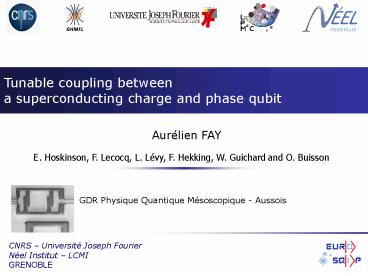MOTIVATION - PowerPoint PPT Presentation
1 / 31
Title: MOTIVATION
1
GDR Physique Quantique Mésoscopique - Aussois
2
Introduction
- Last decade new experiments in quantum
mechanics using superconducting quantum circuits - two level system superconducting qubit
- multi quantum levels systems
- qubit coupled to high Q cavity
- Last decade new experiments in quantum
mechanics using superconducting quantum circuits - two level system superconducting qubit
- multi quantum levels systems
- Last decade new experiments in quantum
mechanics using superconducting quantum circuits - two level system superconducting qubit
- multi quantum levels systems
- qubit coupled to high Q cavity
- fixe coupling between two qubits
- Last decade new experiments in quantum
mechanics using superconducting quantum circuits - two level system superconducting qubit
3
Motivation for a tunable coupling
Quantum algorithm
Tunable coupling
4
Outline
- Description of the circuit
- dc-SQUID phase qubit
- Asymmetric transistor charge qubit
- Tunable coupling between the charge and phase
qubit - Summary
5
Outline
- Description of the circuit
- dc-SQUID phase qubit
- Asymmetric transistor charge qubit
- Tunable coupling between the charge and phase
qubit - Summary
6
Hybrid superconducting two-qubits system
dc-SQUID superconducting loop interrupted by 2
Josephson junctions
Asymmetric Cooper pair transistor
(ACPT) Superconducting island 0.12 µm2
Nanofab
200 nm
Ibias
Vg
Phase qubit
Charge qubit
10 mm
3-angle shadow evaporation
7
Outline
- Description of the circuit
- dc-SQUID phase qubit
- Asymmetric transistor charge qubit
- Tunable coupling between the charge and phase
qubit - Summary
8
dc-SQUID phase qubit
Ib
V 0
V 2DAl
J. Claudon et al., Phys. Rev. Lett. 91, 187003
(2004)
Strong anharmonicity
level quantization
DU (Ib,FS)
np (Ib,FS)
E. Hoskinson et al., cond-mat/0810.2372v1 (2008)
quantum tunneling
Escape probability
9
Phase qubit spectroscopy
Nanosecond flux pulse
Microwave flux
Ic
Ib (µA)
FS 0.02 F0
Ibias 1890 nA
nS (GHz)
10
Outline
- Description of the circuit
- dc-SQUID phase qubit
- Asymmetric transistor charge qubit
- Tunable coupling between the charge and phase
qubit - Summary
11
Charge qubit spectroscopy
ng CgVg/2e
d(FT, FS,Ib)
Micro-wave (mW)
12
Charge qubit frequency versus ng
C2
ng
C1
ng 0.5
nT (GHz)
Pesc
n (GHz)
ng - 0.5
13
Charge qubit frequency versus d
Ej2
d(FT, FS,Ib)
ng 0.5
Ej1
optimal point (d 0, ng 0.5)
nT (GHz)
optimal point (d p, ng 0.5)
Josephson asymmetry
p/2
p
0
14
Rabi oscillations (charge qubit)
Vg
mwave duration
Amw
T2Rabi 110 ns
Pesc
mw duration (ns)
15
Relaxation (charge qubit)
T1 0.8 ms
Pesc
16
Outline
- Description of the studied circuit
- dc-SQUID phase qubit
- Asymmetric transistor charge qubit
- Tunable coupling between the charge and phase
qubit - Summary
17
Coupled qubits spectroscopy
Spectroscopy at Ibias 1890 nA
Charge qubit
I50 (µA)
Phase qubit
Frequency (GHz)
Frequency (GHz)
18
Entangled qubits
g 110 MHz
SQUID 1,-gt
Pesc
g
Frequency (GHz)
19
Spectroscopy versus ng
ACPT
nT
Resonant coupling at ng 0.5
nS does not depend on ng
dc-SQUID
nS
nr 18.98 GHz
g 110 MHz
20
Spectroscopy versus flux
Spectroscopy at Ibias 1890 nA
Spectroscopy at Ibias 2140 nA
Spectroscopy at Ibias 107 nA
nr 10.4 GHz
g 900 MHz
I50 (mA)
Frequency (GHz)
Frequency (GHz)
- Two qubits can be in resonance from 9 GHz to 20
GHz. - Strong variation of the coupling strength.
21
Resonant coupling
Coupling varies from 60 MHz to 1100 MHz
factor of 18
g (GHz)
nr (GHz)
22
Electrical schematic of the circuit
23
Hamiltonian of the coupled qubits
Josephson energy asymmetry
Capacitance asymmetry
24
Resonant coupling
A. Fay et al., PRL 100, 187003 (2008)
We consider ? ? ? ? ???6?
g (GHz)
nr (GHz)
25
Resonant coupling
A. Fay et al., PRL 100, 187003 (2008)
We consider ? ? 37.7? and ? ? ???6?
g (GHz)
nr (GHz)
If transistor was symmetric (lm0) coupling
would be zero
26
Outline
- Description of the studied circuit
- dc-SQUID phase qubit
- Asymmetric transistor charge qubit
- Tunable coupling between the charge and phase
qubit - Summary
27
Summary
- Two different qubits
- Strong tunable coupling between
- a charge and phase qubit (x18)
- Zero coupling and non-zero coupling
28
Outline
- Description of the studied circuit
- dc-SQUID phase qubit
- Asymmetric transistor charge qubit
- Tunable coupling between the charge and phase
qubit - Measurement of the charge qubit
- Summary
29
Energy levels
Measurement
I50 (mA)
Flux pulse
Flux pulse
Measurement
30
Landau-Zener and adiabatic passage
coupling
speed
Eb
Er
LZ passage PLZ 1
2g
Adiabatic passage PLZ 0
x
Eb
Er
31
Measurement of the ACPT
Flux pulse
Adiabatic passage
g 800 MHz
Phase qubit
Charge qubit































